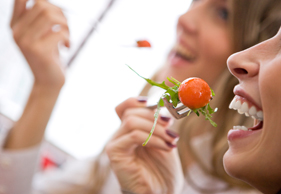What you eat is important, but even
healthy food can stop you from losing weight if you eat too much of it.
Dieticians never recommend extreme calorie restriction, but there are some
tricks you can use to slightly reduce the amount of food you eat without
feeling deprived. Remember, your brain is easily fooled by shifts in
perspective. It’s also more responsive to external cues like an empty plate
than internal cues like a full stomach. Understanding these influences can show
you how to tilt them in your favour. Over time this calorie difference can help
you drop weight. It’s slow, but it’s steady. And best of all, it’s painless.
1. SMALL PLATES, TALLER GLASSES
A full plate sends the signal that
you’re eating a full meal and a partially full plate looks like a skimpy meal,
regardless of the actual quantity of food. Therefore, using smaller plates and
filling them up is a proven way to eat less without noticing. Also, you can cut
down on your liquid calories by choosing taller glasses rather than shorter,
fatter ones.
2. SNACKS OUT OF
SIGHT
People eat a lot more when food is
visible. Research has also demonstrated that the harder food is to get to, even
if the extra effort is just removing a lid or walking to the cabinet, the less
likely you are to eat it. The extra work forces you to talk yourself out of a decision
you may regret later.
3. DON’T EAT FROM
THE PACKAGE
Your stomach can’t count. When you can’t
see how much you’re eating, you’re more than a little likely to lose track and
consume double or even triple the amount you’d eat if you took the time to
serve yourself a proper portion. Use a plate or napkin, to make sure you get a
good visual of everything you’re going to eat.
4. CHOOSING FAST
FOODS
?
Portion
control: Choose the smallest size available.
?
Add
colour: Foods with colour contain more vitamins, minerals and
antioxidants.
?
Know
what’s in your food: Spend
some time looking at the nutritional information for your favourite take-away.
?
Choose
fatter chips: If you have to
have some sort of fried potato, choose wedges or thick-cut chips if they are
available, as thinner fries absorb more oil.
?
Be
salad smart: Salad can be a
nutritious, low-kilojoule option, or it can be laden with fat. Keep an eye on
what you include in your salads!
5. BE FOOD CONSCIOUS
Don’t eat while doing something else,
like watching TV, reading or working. Eat slowly and enjoy your food.
6. THOSE TRICKY FOOD SITUATIONS
Make a plan including strategies for
handling challenging food situations, such as parties or festive foods at work.
Try having a piece of fruit, cup of yoghurt, half a lean deli meat sandwich, or
a few crackers with low-fat cheese ahead of time, to avoid arriving at the
party famished and then overeating.
7. UNDERSTAND YOUR FOOD BEHAVIOUR
If we don’t understand our own triggers
and patterns of behaviour with food, it can make it difficult to change. For
example, do you eat when you’re stressed or tired?
8. DON’T THINK OF GETTING TO ‘THE END’
Making permanent, sustainable change is
the constant theme! You don’t reach the goal and then you’re finished. Life
isn’t like that. It’s about navigating the good times and the bad times.
Remember: it’s about what you do all the
time, not about what you do sometimes. Here’s to a happy,
healthy 2013!

